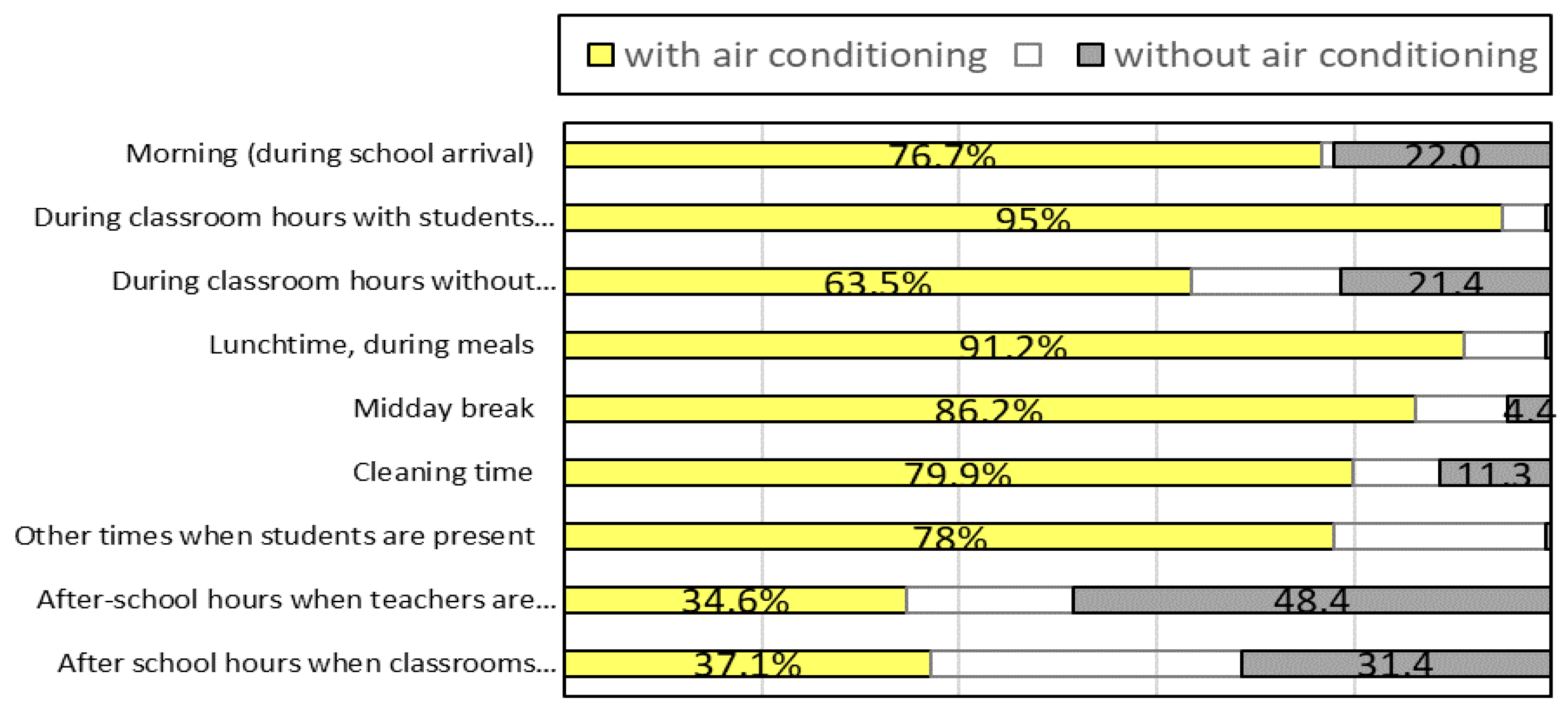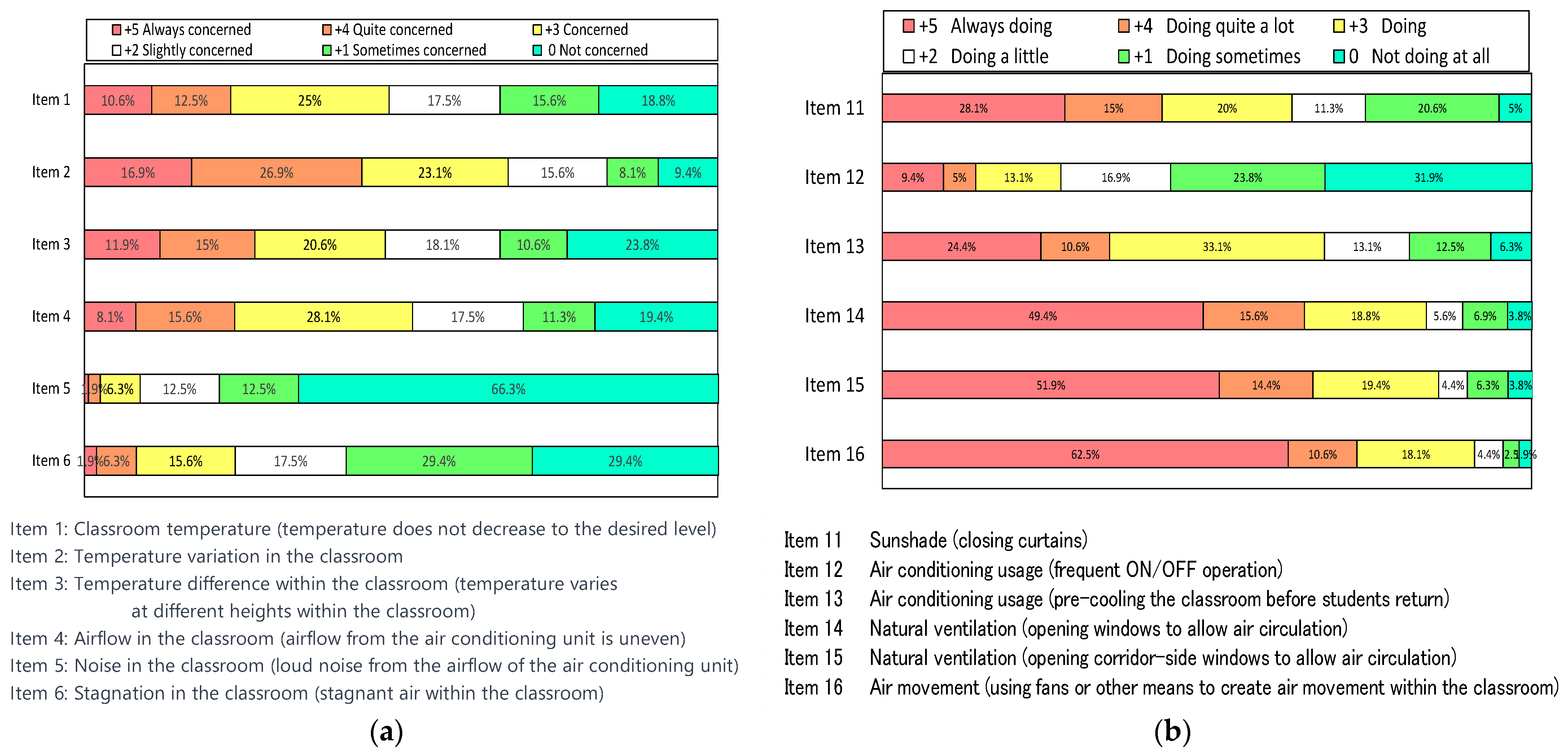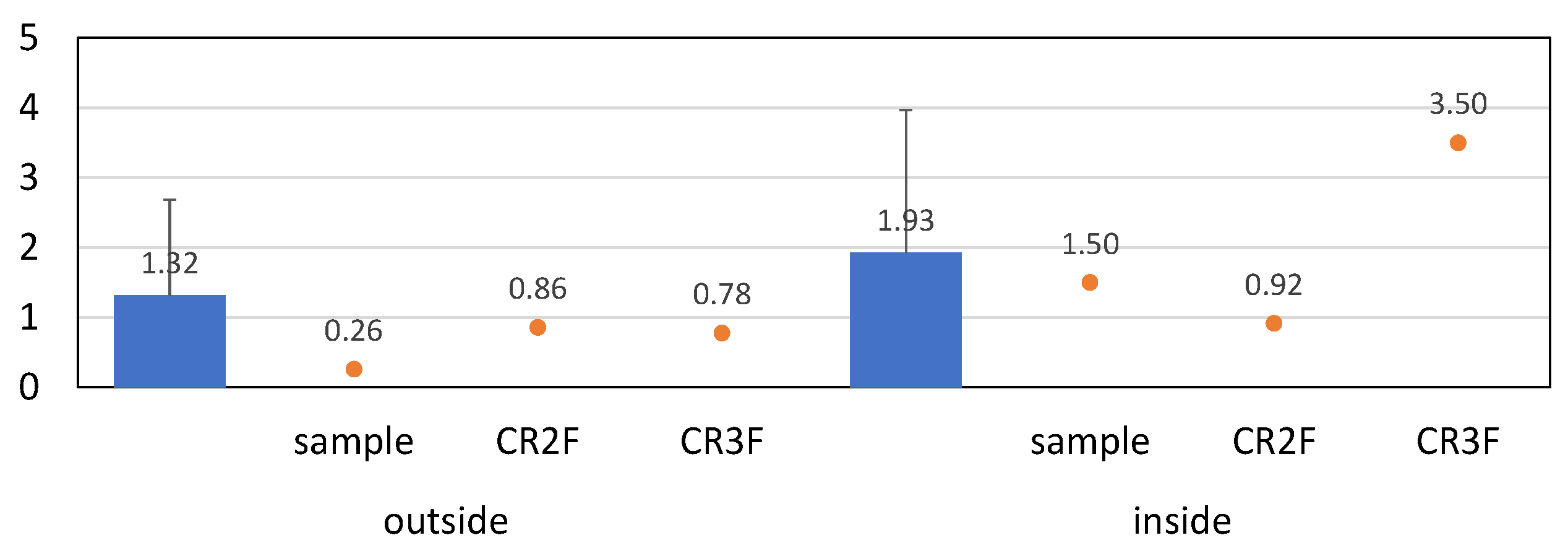1. Introduction
Japan aims to achieve carbon neutrality by 2050 and reduce CO2 emissions by 46% by 2030. In the construction sector, it is planned that the majority of new public facilities will achieve Zero Energy Building (ZEB) status by 2030. School facilities, which account for 40% of public facilities, need to implement measures at an early stage.
Therefore, around 2018, when the government announced the promotion of ZEB in public facilities, the existing school buildings in Shizuoka Prefecture, a warm region, had extremely low insulation performance and minimal building facilities in classrooms. The building facilities in classrooms include lighting, air conditioning, and ventilation systems.
Regarding ventilation systems, due to the lack of installed ventilation facilities in classrooms in Shizuoka Prefecture, the preservation of the learning environment in each classroom relies on the operation of the homeroom teachers [
1,
2]. For COVID-19 prevention measures, manual window opening by teachers is the main method of ventilation.
In this paper, we investigate the operational conditions of teachers and their environmental behavior in primary school classrooms during the summer, with a focus on COVID-19 countermeasures. We aim to grasp the actual situation and demonstrate the potential reduction in heat load achievable through systemization.
In the future, to maintain the classroom environment in X City’s elementary and middle schools while minimizing energy consumption, the introduction of an announcement system in addition to the efforts of teachers is deemed effective.
In this paper, we aim to grasp the operational status and environmental behavior of teachers focusing on COVID-19 measures in summer elementary school classrooms. We calculate the potential reduction in energy consumption by introducing an unmanned environmental notification system that allows users to engage in environmental behavior to achieve a comfortable classroom environment.
In the future, to suppress energy consumption while maintaining classroom environments in elementary and junior high schools in X City, unmanned environmental notification system applications that facilitate appropriate environmental behavior by homeroom teachers will be effective.
2. Methodology
Shizuoka Prefecture is located on the Pacific side of mainland Honshu and is known for its mild climate. Under the Building Energy Efficiency Law, Japan is divided into eight regions for the calculation of target buildings based on regional characteristics. Due to the large area of Shizuoka Prefecture, the cities and towns within the prefecture are divided into five to seven regional classifications.
Therefore, in any region of Shizuoka Prefecture, the transitional period is long, and the duration of heating and cooling through facilities is short. It has been found that public elementary and junior high schools often fail to meet the standards for room temperature set by the government, even when air conditioning is used for both cooling and heating during the summer and winter, according to existing surveys. Classroom environmental maintenance, including ventilation, has primarily been carried out by classroom teachers.
In this study, the target municipality was X City, Shizuoka Prefecture, and a questionnaire survey was conducted targeting teachers who are homeroom teachers in elementary schools. X City has a total of 13 public elementary schools, with 223 regular classrooms and 35 special needs classrooms as the subjects.
The survey was conducted during the summer period from 29 September 2022 to 31 October 2022, for a duration of one month, using the web-based survey platform Forms.
The questionnaire items include demographic information, as well as the following four items: (1) Psychological aspects of students and teachers during the summer as perceived by teachers; (2) Concerns and actions related to air conditioning operation; (3) Concerns and actions related to ventilation; and (4) Actual window opening time and extent.
3. Simulation and Results
A total of 159 responses were obtained from teachers in 10 elementary schools (X City), including 140 homeroom teachers and 19 special education teachers. The effective response rate for homeroom teachers was 62.7%. Responses were received from individuals spanning the age range of 20s to 60s, with relatively equal participation across all age groups. The ratio of male to female respondents was 7:9.
Figure 1 presents the attributes. The distribution of homeroom teachers (
n = 140) based on the grade level they teach and the floor level of their classrooms is depicted in
Figure 1a. When classified into first floor, intermediate floors, and top floor categories, lower grade levels were allocated to lower floors, while higher grade levels were positioned on upper floors, with the top floor classrooms accounting for 41% of the total.
The thermal sensation responses provided by the participating educators are illustrated in
Figure 1b. Approximately 50% of male respondents and 40% of female respondents indicated being either “cold hands and feet” or “sweaty”.
3.1. Results of Psychometric Survey of Students and Teachers
Figure 2 depicts the thermal sensations and satisfaction levels of the children, as perceived by the faculty members, as well as the thermal sensation and satisfaction levels reported by the faculty members themselves. There were no significant differences observed between the faculty’s evaluation of the children’s condition and their own evaluation. Regarding thermal sensation, approximately 75% of both the children and teachers reported feeling “hot”, while 20% of the respondents, including both children and teachers, reported feeling “very hot”. As for satisfaction levels, around 50% indicated being “satisfied”, while approximately 35% expressed some level of dissatisfaction.
Figure 3 illustrates the operating hours and non-operating hours of the air conditioning system, as reported by the faculty members. During instructional periods when students are present or during lunchtime, the operating rate exceeds 90%. However, there is variation in the usage of the system during non-instructional periods when students are not present, such as during cleaning time or after-school hours when teachers utilize the facility. Multiple responses indicated that determining the appropriate operation during these periods is challenging for the faculty members, and it was also difficult to make definitive judgments based on the written responses.
Figure 4 displays the actual temperature settings adjusted by the faculty members using the remote control, as well as their desired temperature settings. According to the air conditioning system operation guidelines provided by the Education Committee of X City, a recommended temperature range of 26 to 28 degrees is suggested for remote control settings. Among the faculty members, the temperature setting of 26 degrees accounted for 48% of the total responses. On the other hand, the desired temperature settings indicated by the faculty members were predominantly in the range of 24 to 26 degrees, representing three-fourths of the total responses. This reveals that the faculty members have not lowered the temperature setting to match their desired settings.
3.2. Points of Teachers’ Environmental Behavior
Figure 5a presents the evaluation of environmental factors as perceived by the faculty members, categorized by assessment items. They rated the environmental factors during classes on a 6-point scale.
Regarding the temperature distribution in the classroom (item 2), approximately two-thirds of the faculty members responded with ratings indicating concern (ratings +5, +4, or +3). Furthermore, for the following three items: (1) inability of the classroom temperature to reach the desired level, (2) temperature differences at different heights within the classroom, and (3) uneven distribution of air conditioning airflow, each of them garnered concern ratings (ratings +5, +4, or +3) from approximately half of the respondents. On the other hand, approximately two-thirds of the faculty members reported not being concerned about noise in the classroom (specifically, noise generated by the air conditioning system airflow).
Figure 5b presents the evaluation of the environmental behaviors carried out by the faculty members, categorized by assessment items. These behaviors were also rated on a 6-point scale.
Regarding classroom ventilation, approximately 80% of the faculty members responded with ratings indicating that they consciously engage in actions such as “Opening the outer windows” (item 13) and “Opening the hallway windows” (item 15), as well as “Stirring the indoor air with a fan” (item 16). Regarding sunshade measures, the most commonly reported behavior was “Closing the curtains” (item 11), accounting for 63% of responses. As for air conditioning usage, measures such as “Pre-cooling the room in accordance with the children’s usage” (item 15) were reported by 54% of the faculty members.
3.3. Window Opening Amount and Opening Time during Cooling
The relationship between the open area during class and the open area during cleaning is shown in
Figure 6. The horizontal axis represents the classroom window open area during class, with an average of 2.80 square meters (SD ± 2.90). This average corresponds to an air exchange rate of 5.8 exchanges per hour when a natural wind speed of 0.5 m/s is introduced. Conversely, at the ventilation rate specified by the school environmental hygiene standards of 2.2 exchanges per hour, the open area is 0.476 square meters when the wind speed is 0.5 m/s. The vertical axis represents the difference in open area between cleaning and class hours.
It can be observed that the open area during cleaning significantly differs from that during class hours, as X City recommends window opening as a COVID-19 countermeasure in each elementary school. According to the calculations based on teacher reports for the second-floor classroom (Q Elementary School), the open area during class hours was 0.48 square meters. However, the average CO2 concentration measured in the classroom was 1023 ppm, exceeding 1000 ppm in approximately 60% of the time when students were present. On the other hand, for the third-floor classroom (Q Elementary School), the calculated open area during class hours based on teacher reports was 4.42 square meters. The measured CO2 concentration in the classroom had an average of 591 ppm, and it did not exceed 1000 ppm during student occupancy. The significant variation in open area reported by teachers indicates that in some cases, excessive ventilation may occur due to the discretion of individual teachers.
Figure 7 presents the calculated classroom opening areas for indoor and outdoor spaces based on teacher reports, along with actual measurement examples. The average values reported by teachers indicate an average opening area of 1.32 square meters for outdoor spaces and 1.93 square meters for indoor spaces, but with significant variation. In the case of classrooms where “sufficient ventilation was achieved”, the opening area towards the outdoor environment accounted for only 14% of the total.
Figure 8 presents the results of thermal load calculations [
3] per classroom for four different cases (Case 1 to Case 4) conducted in Q Elementary School, categorized into upper and intermediate floors. Cases 1 and 3 represent scenarios where ventilation is ensured, while Cases 2 and 4 are calculated based on the average values derived from the teacher-reported data in
Figure 8. For Cases 1 and 2, the room temperature was set at 28 degrees Celsius, while for Cases 3 and 4, it was set at 26 degrees Celsius.
By transitioning to “cases with sufficient ventilation,” the thermal load of the classrooms can be reduced by 26% for the upper floor with a 28-degree setting, and by 12% for a 26-degree setting. Similarly, for the intermediate floor, the reduction amounts to 38% for a 28-degree setting and 23% for a 26-degree setting.
The thermal load reduction for Q Elementary School was calculated for each case. In the scenario where sufficient ventilation is ensured (Case 3), a 31% reduction in thermal load is achievable compared with the current state of all regular classrooms (Case 4) at a 28-degree setting, and a 20% reduction at a 26-degree setting. When the calculation is extended to the entire Q Elementary School with a 26-degree setting, the thermal load on the hottest day, which was initially 7151.48 MJ, can be reduced to 5722.83 MJ.
4. Conclusions
In this paper, the following findings were obtained:
The designated air conditioning temperature in X City is 26 to 28 degrees Celsius, but the majority of teachers operate it at 26 degrees Celsius and express a preference for temperatures ranging from 24 to 26 degrees Celsius.
The homeroom teacher is particularly attentive to ventilation among the classroom environmental conditions and takes actions such as opening windows and using fans. However, these environmental practices are being carried out without any scientific basis.
Natural ventilation during air conditioning shows significant variation in terms of window opening size and duration, as determined by individual teacher judgment, leading to instances of excessive ventilation compared to the required amount.
By implementing an announcement system that encourages appropriate environmental behaviors, it is estimated that classroom thermal load can be reduced by approximately 20%, resulting in a potential reduction of 1400 to 2000 MJ in thermal load on the hottest days at the school level.













